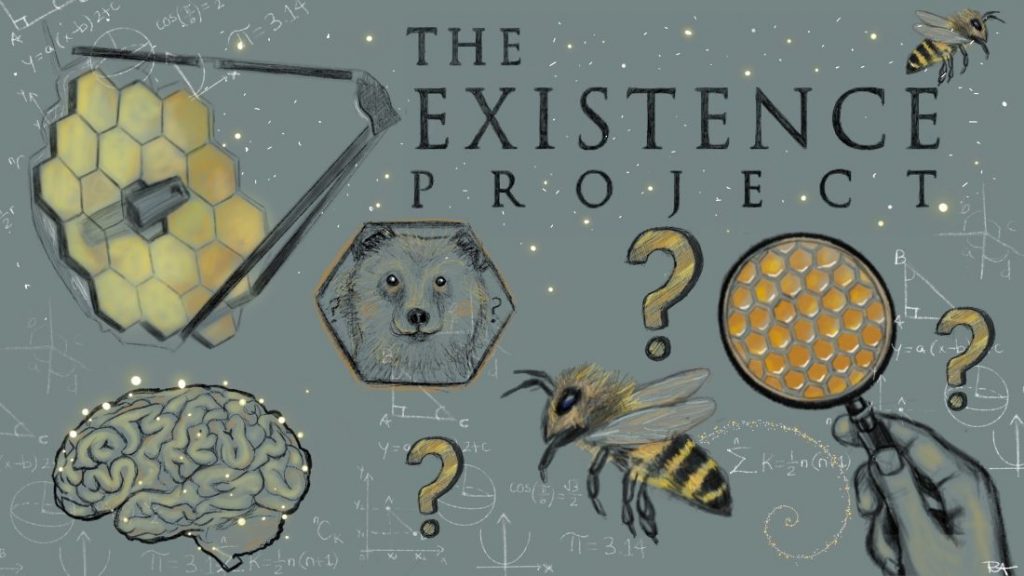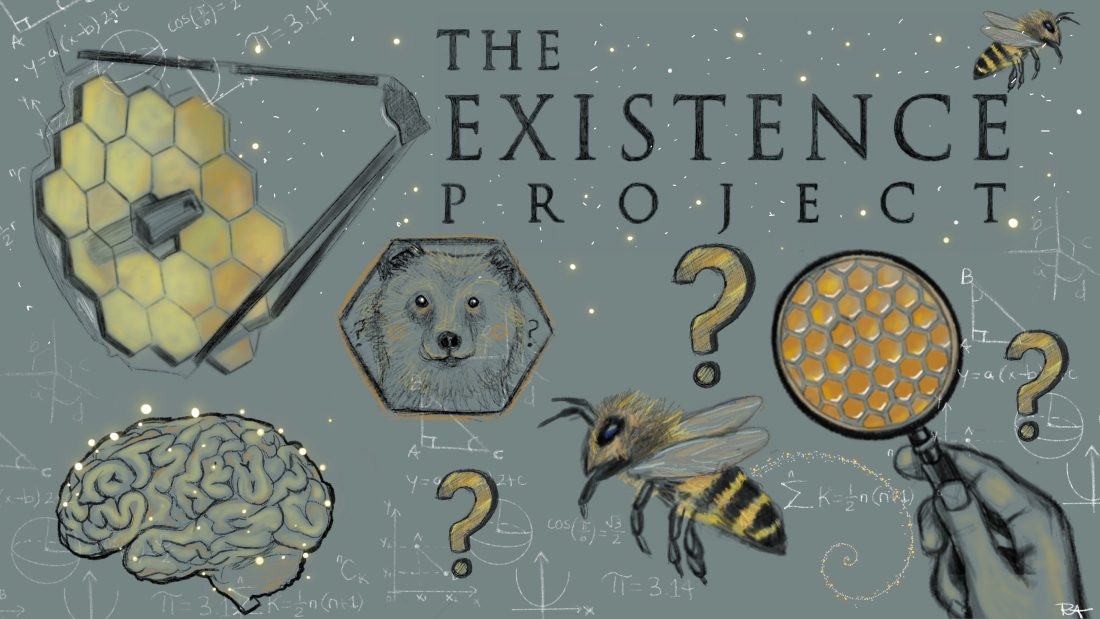
(Artist: Rija Ahsan)
Sabahat Ali, USA
The Divine Game of Hide & Seek
For all our curiosity, we human beings can be awfully good at looking for things in all the wrong places. Phones in the fridge. Keys in the oven. That kind of thing.
But the greatest mistakes we make are in the pursuit of the greatest causes: wealth, love, belonging, identity. And believe it or not, the timeless quest for God is no exception.
In the debate about God’s existence, we often look for laboratory evidence suited to physical-material things rather than divine architecture. But even an ocean-full of salt water won’t quench our thirst. When the nature of what we seek is at odds with the instruments we use to seek it, the truth can feel a whole universe away.
Hundreds of Conversations. One Bad Argument.
Across the hundreds of conversations I’ve now had with atheists through The Existence Project, they all seem to expect evidence for God that would imply that God is, well, not very Godly. Usually, it’s the kind we’d naturally expect when proving the existence of a physical object. But this approach misses a fundamental point: the God described by prophets has never been claimed to be a physical entity in the first place.
A qualifying note: knowing what constitutes evidence of God doesn’t minimize the existential voyage – it beautifies it. This is why, when we ask for proof of anything, it has to always be consistent with the attributes, qualities and characteristics of the thing we seek.
What’s Wrong With Asking the Wrong Questions?

I would never demand to smell electromagnetic radiation. Or insist on hearing the heat of a pepper (I would need to taste it). To prove that a Vaquita exists – arguably the rarest marine animal in the world – I’d have to present very different evidence. DNA samples, an actual specimen, records verified by experts – each thing requires proof that is consistent with its nature and traits.
But what if I wanted proof for something that happened in the past? The distance that time places between us here doesn’t allow us to observe the past in the way we experience our here and now.
To demonstrate something that happened in the past, I would have to adjust my definition of evidence slightly. Historical sources, carbon-dating, written or media records, oral accounts or eye-witness testimony might replace a live specimen. But if I insisted that I have to see the past taking place exactly how it took place, I would never be satisfied.
Yet, when it comes to the ultimate origins of the universe, we often end up making such erroneous demands.
No Bearded Men in the Sky: The God That Actually Exists

© Shutterstock
At the very origin of every major faith, God Almighty was never a vague concept concocted in a philosopher’s cauldron. It was only when the followers of religion lost the true essence and teachings that people felt the need to philosophize God back to relevance. And it’s in this process that more problems arose than were resolved.
This is why the original, untainted teachings around God in every major faith seem so far-flung a departure from the body of theistic arguments found today. The Prophets of God talked about the Creator in profound terms that everyone could understand. Divine knowledge was never the intellectual monopoly reserved for the top one percent of society’s IQ.
The Prophet Muhammad (sa), for instance, brought the world back to what all prophets before him had espoused: that God’s attributes are consistent with the observed realities of our universe. Without a physical body, God has always been described as the necessary beginning that precedes everything else. He is what shall remain after entropy swallows the universe whole. He is the mind behind the curtain of reality and the heart at the centre of morality.
However, there is one thing that this Supreme Intelligence, Grand Architect, Law-Giver – whichever of the names that the ingenious design and function of our universe begs we give Him – is certainly not: a bearded man in the sky.
Do Believers Hide Behind God’s Invisibility?

© Shutterstock
“Well isn’t that convenient,” our atheist friends like to joke. (Although it’s apparently a valid counter at first glance). When atheists criticize me for believing that a bearded man in the clouds is running the show, (and I’ve lost count of the number who have) I calmly inform them that I don’t. At all. But then they have another counter: “How convenient that your God can’t be seen, heard touched or physically sensed in any way.”
But (I proceed to tell them), as we go up the ladder of more foundational and powerful forces that govern the universe – the more significant it is in the operation of the cosmos, the more elusive it becomes to the naked eye. Dark energy, gravity, quantum fields, information as a physical force, entanglement, vacuum energy – have your pick.
So it is proven by all the greatest fundamental forces that hold up this glittering black stage we call the observable universe: if there is a force behind all these forces, it will stand to reason that it must be proportionately elusive to the physical crucibles of material observation.
It has to be transcendent, foundational, so close to our eyes that if we don’t take a step back, we’ll miss it. Sure: it helps to stop and smell the roses. But it helps a great deal more to ask about the gardener who planted them.
So whether you dub the force guiding our universe along as intentional and deliberate or chaotic and blind, one thing cannot be denied: it’s there.
So, what in heaven’s name can we consider proof for something so elusive?
Are Patterns Proof? Between Math and Honey.

© Shutterstock
Consider the humble hexagons of honeybees – a profound intersection between biology and mathematics that betrays the hidden hand of Divine design.
For a long time, scientists debated whether honeybees consciously construct the hexagonal shape of their honeycombs using some mysterious geometry. Thanks to Thomas Hales, who proved that hexagons are actually nature’s most efficient space-savers (covering a maximum amount of area with minimal wall space between each cell), the IQ of the bees won over the fancy of scientists just as much as the IQ of nature itself became part of the discussion. [The hexagonal shape of the honeycomb cells depends on the instruction behaviour of bees] ^(https://www.blogquicker.com/goto/https://www.nature.com/articles/srep28341.pdf)
But that was only the beginning. As researchers were quick to point out, the bees weren’t really doing math consciously. They instinctually formed circles that would “become” hexagons. And this is important, because if the bees aren’t doing the math, then who is?
Is Nature Accidentally Smart?

© Shutterstock
We’ve become so exultantly obsessed with explaining nature’s elegance that the deeper question of “why is it elegant at all?” sadly escapes us.
Recently, PLOS biology – a scientific journal – published a study that makes a case for both truths. The bees know enough to get the right answer – down to the millimeter while constructing impeccable 120-degree angles – but not enough to understand how they did it.
The case for nature being propelled by an all-intelligent force requires proof that what’s happening is intelligent and not random. Hence, these bees demonstrate that nature excavates the treasure of mathematical principles that independently exist beyond the physical curtain of reality.
Mathematics is a combination of biological life’s pursuit to make sense of the universe, but the universe itself is also one which makes mathematical sense to begin with. Also known as intelligibility, this makes the exploration of our world even more mysterious and exciting.
Does the Universe Speak in Numbers?

© Shutterstock
So why is intelligibility “the right kind of proof” for an intelligent designer?
We crave language models to make sense of the universe because the universe itself is comprised of mathematical language models to make sense of. It is not – as claimed by many a modern physicist – just evolving by happenstance and unravelling with absolute randomness. Rather, what appears to us as random on the quantum level – when zoomed-out – reveals a breathtaking emergence of order. That the apparently chaotic randomness at the hyper-microscopic level somehow manages to conjure up the genius of the Fibonacci sequence and countless other examples of harmony is case-in-point.
Mathematical principles in nature are not always consciously implemented by nature itself, but that does not mean that there is no consciousness behind the math.
We have become so good at explaining the microscopic and defining evidence for the physical world that we’ve confused explanations for understanding. It’s a dangerous gamble – to look so closely at the individual parts of a thing that you miss the big picture entirely.
The Story of 10 Nests & 179 Million Years

After analyzing nearly 23,000 individual cells across ten different nests of both wasps and honeybees (despite the fact that they evolved independently for 179 million years) the PLOS biology study found that what the bees are doing “is consistent with fundamental geometric rules, showing a level of intelligence humans consistently do not expect from insects.” ^(https://www.blogquicker.com/goto/https://www.salon.com/2023/07/27/scientists-just-learned-how-bees-and-wasps-build-their-nests-with-hexagons--and-it-blew-their-minds/)
Another critical characteristic of proof for God is something that atheists rightfully demand: where’s the consistency? If there is in fact a reality that exists independent of our observation of it, an objective truth, then where is the proof?
Can Evolution Remember What It Never Knew?

© Shutterstock
Despite evolving separately for millions of years, honeybees and wasps both came to a conclusion that was mathematically consistent, demonstrating that mathematical truths are fundamentally a part of the fabric of reality and not just what atheists may dub “human constructs.”
Even without conscious calculation, nature is impelled toward a reality that exists independently of any human equations or computations.
Dr. Michael Smith from Auburn University’s Department of Biological Sciences was the corresponding author of the fascinating piece featured in Salon. He observed,
“I think the most interesting result is that we’re finding that collective systems come up with the same solutions for the same problems, despite being separated by millions of years of evolution.”
Evolution may be blind, but it certainly knows math. (I’m joking about the blind part, of course). When different evolutionary paths—separated by 179 million years—arrive at identical mathematical solutions, we’re witnessing more than convergence; we’re seeing the discovery of pre-existing mathematical truths. I’m always amazed when atheists announce with great victory in their voice that evolution is blind with nothing intelligent guiding it, while simultaneously observing that it consistently converges toward fundamental mathematical truths.
Why Don’t Bears Build Hexagons?

© Shutterstock
I can already hear some skeptics responding: “well, what about all other species? Why didn’t they come to this universal truth of hexagons?”
It’s painfully simple: different challenges demand different solutions. Every animal and species is positioned to draw upon mathematical truths that serve their specific purposes.
A hexagon would not resolve the problems of other animals like it does with bees and wasps. It’s the hallmark of a truly cosmic architect: that even through the decimal-point consistency of His architecture shines a dazzling display of diversity.
Nature consistently discovers rather than invents the design that is inherently present and maximizes benefitting from it on a case-by-case basis.
It’s the definition of wisdom.
Is Anyone Home? The Locked House With No One Inside

© Shutterstock
For now, I’ll leave you with an example that makes for a great conversation-starter no matter what your position.
If a house has several doors all locked from the inside, it is absurd to purport that there is no one who’s locked it, but that it just naturally became locked over time. When all the signs point to an emergent mathematical consistency in every element of the universe, to keep insisting that there is no method to the mathematical madness is only madness squared.
So when we ask for proof of God – are we being honest when we stipulate conditions that are inherently incoherent?
Or does it make more sense to demand certainty of an infinite God’s existence using a big-picture paradigm? After all, isn’t our ability to see the bigger picture arguably the greatest gift of the human mind?
Mind the Gap Between the Brain & the Platform

© Shutterstock
Regarding this, the Fourth Caliph and Worldwide Head of the Ahmadiyya Muslim Community, Hazrat Mirza Tahir Ahmad (rh), writes:
‘The mind is the ultimate seat of consciousness. [It] has the power to contemplate upon metaphysical and conceptual issues like infinity and eternity. It endeavours to resolve the enigma of a seemingly endless chain of cause and effect. Where did a certain thing begin and what lies beyond every beginning? Was there a first cause preceding all other causes? If so, was that first cause living and conscious, or was it dead and mindless? The only rational conclusion the mind can draw is that the first cause could not be unconscious and dead.’ [Revelation, Rationality, Knowledge, and Truth, Mirza Tahir Ahmad, Islam International Publications, 1988, pg. 273]
The paradox of why believers can never pull a piece of God out of their pockets evaporates when we realize that seeking the intangible Divine signature of the cosmos requires the intangible laboratory of the human mind.
So when people ask me to furnish evidence of the metaphysical, I say: are you ready to ask for the right evidence – to consider that maybe we aren’t just doing the math – maybe we are the math.
Because if you’re ready to ask for the right kind of proof – I’ve got a universe full of it.
About the author: Sabahat Ali is a missionary of the Ahmadiyya Muslim Community in The Review of Religions and serves as the Editor of The Existence Project.
#Problem #Proving #God #Pushing #Limits #Understanding



